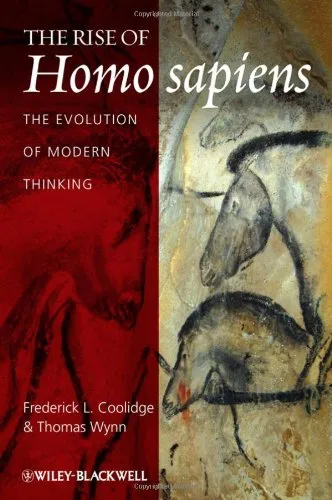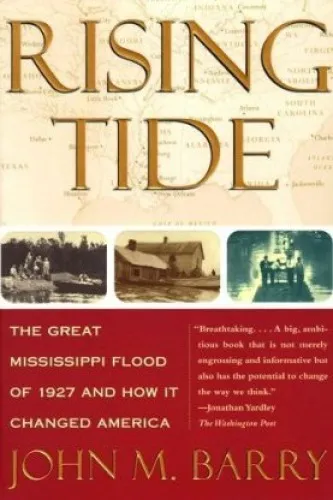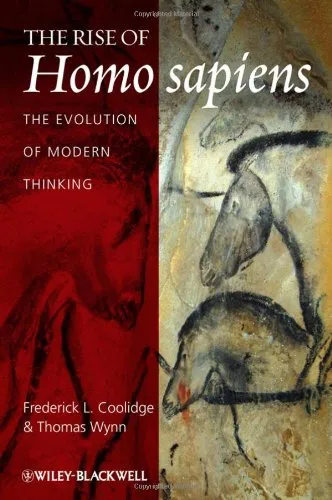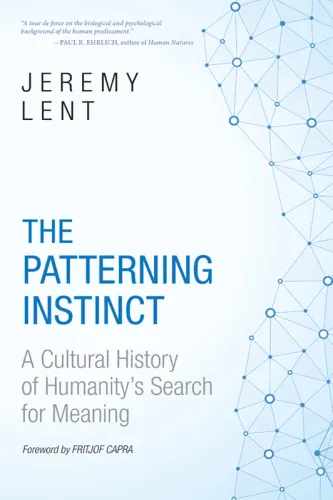The rise of Homo sapiens: the evolution of modern thinking
4.3
بر اساس نظر کاربران

شما میتونید سوالاتتون در باره کتاب رو از هوش مصنوعیش بعد از ورود بپرسید
هر دانلود یا پرسش از هوش مصنوعی 2 امتیاز لازم دارد، برای بدست آوردن امتیاز رایگان، به صفحه ی راهنمای امتیازات سر بزنید و یک سری کار ارزشمند انجام بدینکتاب های مرتبط:
انسانشناسی همواره تلاش کرده است تا تاریخچه تکامل بشر را با جزئیات بیشتری بشکافد و بفهمد که چه چیزی گونه ما را، یعنی Homo Sapiens را، منحصر به فرد کرده است. کتاب The Rise of Homo Sapiens: The Evolution of Modern Thinking نوشته فردریک ال. کولیج و توماس وین، به بررسی عمیق این پرسش میپردازد. این کتاب نه تنها دستاوردهای علمی را در این زمینه بازتاب میدهد، بلکه به جنبههای روانشناختی، شناختی و فرهنگی تکامل بشر میپردازد و نقش این فاکتورها را در شکلگیری تفکر مدرن تحلیل میکند.
این کتاب یک تلاقی جذاب از علوم مختلف نظیر روانشناسی تکاملی، باستانشناسی، انسانشناسی و علوم شناختی است. نویسندگان با استفاده از شواهد گسترده علمی، تلاش کردهاند تا به این پرسش پاسخ دهند که چه چیزی باعث شد انسان مدرن تفکری چنین خلاق و پیچیده داشته باشد و چگونه این تفکر به فرهنگ و تمدن بشر امروز منجر شد. در ادامه، به بررسی دقیقتر محتوای این کتاب خواهیم پرداخت.
خلاصهای جامع از کتاب
کتاب «The Rise of Homo Sapiens» در چند فصل کلیدی سازماندهی شده است که هر فصل به یک جنبه مهم از تکامل شناختی انسان میپردازد. نویسندگان در ابتدای کتاب، پیشینه تکاملی بشر را مورد کاوش قرار میدهند و توضیح میدهند که چگونه Homo Sapiens از دیگر گونههای انسانی مانند نئاندرتالها متمایز شده است. سپس با بررسی تاریخچه ابزارسازی، زبان، هنر و فرهنگ، ارتباطات پیچیده انسانی بررسی و تحلیل میشود.
بخش قابل توجهی از کتاب به نقش زبان در تکامل انسان اختصاص داده شده است. زبان نه تنها ابزار ارتباطی بوده، بلکه وسیلهای برای گسترش تفکر نمادین، خلاقیت و اجتماعیشدن نیز بوده است. این کتاب توضیح میدهد که چگونه توسعه تفکر مدرن، ظهور ابزارهای پیچیدهتر، ایجاد ساختارهای اجتماعی و در نتیجه شکلگیری فرهنگ انسانی را امکانپذیر کرده است.
نکات کلیدی کتاب
- بررسی فرآیندهای شناختی که Homo Sapiens را از دیگر گونههای انسانی متمایز کرد.
- تحلیل نقش زبان در تکامل اجتماعی و فرهنگی انسان.
- بررسی شواهد باستانشناسی از خلاقیت و نوآوری در ابزارسازی انسان اولیه.
- بحث در مورد تفکر نمادین و نقش آن در شکلدهی هنر و مذهب.
- توضیح تأثیرات تحولات زیستشناختی بر فرآیندهای شناختی انسان.
جملات برجسته کتاب
«زبان، نه فقط وسیلهای برای ارتباط، بلکه یک چارچوب شناختی است که به ما امکان میدهد تا جهان را به شیوهای نمادین بررسی کنیم.»
«فرهنگ، خود نتیجه تکامل پیچیده ساختارهای اجتماعی و تمایلات شناختی است که در طول نسلها شکل گرفتهاند.»
چرا این کتاب مهم است؟
این کتاب برای کسانی که علاقهمند به مطالعه در حوزه تکامل بشر هستند، ضروری است. نویسندگان با دیدگاههای چندرشتهای و با استفاده از شواهد علمی، توانستهاند تصویری جامع از فرآیند تکامل شناختی بشر ارائه دهند. این کتاب به خوانندگان کمک میکند تا بهتر بفهمند چگونه تفکر انسانی پیشرفتهای که امروزه داریم، شکل گرفته است. همچنین، این اثر به خوبی کمک میکند تا جایگاه یگانه Homo Sapiens در میان سایر گونهها درک شود.
Introduction to "The Rise of Homo Sapiens: The Evolution of Modern Thinking"
"The Rise of Homo Sapiens: The Evolution of Modern Thinking," written by Frederick L. Coolidge and Thomas Wynn, is a groundbreaking exploration into one of the most fascinating topics in human history: the dawn of modern thought. This book delves deep into our evolutionary past to unravel the cognitive advancements that have made Homo sapiens the predominant species on Earth. Through a multidisciplinary lens, leveraging insights from archaeology, cognitive science, anthropology, and psychology, the authors examine the milestones in the evolution of modern human cognition.
The book is not merely an academic reflection but also a well-structured narrative that makes complex subjects accessible to a broad readership. Fascinating insights, sharp analyses, and poignant questions guide readers through humanity's intellectual transformation over the millennia. By addressing questions like when and how modern thinking first emerged, "The Rise of Homo Sapiens" offers profound perspectives on topics such as language, creativity, technological innovation, and social dynamics. This introduction summarizes the core themes of the book, its key insights, and why it matters in today’s era of self-reflection on human progress.
Detailed Summary of the Book
"The Rise of Homo Sapiens" begins by tracing the evolutionary lineage of hominins, focusing on critical differences in cognitive capabilities between Homo sapiens and earlier human species like Homo erectus, Neanderthals, and Denisovans. The authors explore the unique neurological and developmental changes that set Homo sapiens apart, including the expansion of the prefrontal cortex and advancements in working memory capacity.
One of the book's central arguments is the importance of working memory, which the authors suggest as the key driver behind the rapid development of problem-solving, symbolic thinking, and cumulative culture. With an emphasis on creativity, the ability to plan ahead, and complex social dynamics, Coolidge and Wynn propose that these skills were not only culturally transformative but also essential for survival in challenging prehistoric environments.
The book also discusses the archaeological evidence of symbolic behavior, including the use of pigments, portable art, and tools, which demonstrate increasing creativity and communication skills. Furthermore, it dives into language evolution, a hallmark of modern human thought, examining how language might have been shaped by and, simultaneously, shaped our cognitive abilities.
Unlike standard evolutionary books, this work provides a forward-looking consideration of how understanding the cognitive evolution of our ancestors can shed light on contemporary human behavior, intelligence, and the ongoing development of modern society.
Key Takeaways
- The emergence of modern cognitive abilities was gradual, with key breakthroughs in working memory and symbolic thought.
- Brain size alone does not explain cognitive superiority; the evolution of specific neurological structures played a significant role.
- The development of language and creativity was pivotal in the success of Homo sapiens compared to other species.
- Social cooperation and cumulative culture distinguish Homo sapiens from other early humans.
- Understanding our cognitive past can foster deeper insights into contemporary human challenges and achievements.
Famous Quotes from the Book
"The story of human evolution is not just the survival of the fittest, but the survival of the most adaptable thinkers."
"Modern cognition was not the product of a single leap, but the result of millions of years of gradual, complex changes."
"Symbolism was more than art; it was a lifeline to humanity’s innovation and emotional complexity."
Why This Book Matters
"The Rise of Homo Sapiens" is not just a study of ancient humans; it’s a roadmap for understanding the very essence of what it means to be human. At a time when humanity faces unprecedented technological and social transitions, reflecting on our cognitive past can offer answers to pressing questions about identity, creativity, and adaptability. This book matters because it bridges the gap between science and philosophy, shedding light on how our evolutionary successes and failures can help navigate the challenges of today and tomorrow.
For educators, scholars, and general readers alike, the book serves as an essential resource. It illuminates the connections between our biological evolution and the extraordinary cultural and social changes that define the human experience. By deeply understanding our shared heritage, we gain not only an appreciation of our uniqueness but also a sense of responsibility toward fostering the positive continuance of human creativity and cooperation.
دانلود رایگان مستقیم
شما میتونید سوالاتتون در باره کتاب رو از هوش مصنوعیش بعد از ورود بپرسید
دسترسی به کتابها از طریق پلتفرمهای قانونی و کتابخانههای عمومی نه تنها از حقوق نویسندگان و ناشران حمایت میکند، بلکه به پایداری فرهنگ کتابخوانی نیز کمک میرساند. پیش از دانلود، لحظهای به بررسی این گزینهها فکر کنید.
این کتاب رو در پلتفرم های دیگه ببینید
WorldCat به شما کمک میکنه تا کتاب ها رو در کتابخانه های سراسر دنیا پیدا کنید
امتیازها، نظرات تخصصی و صحبت ها درباره کتاب را در Goodreads ببینید
کتابهای کمیاب یا دست دوم را در AbeBooks پیدا کنید و بخرید
1291
بازدید4.3
امتیاز0
نظر98%
رضایتنظرات:
4.3
بر اساس 0 نظر کاربران
Questions & Answers
Ask questions about this book or help others by answering
No questions yet. Be the first to ask!














